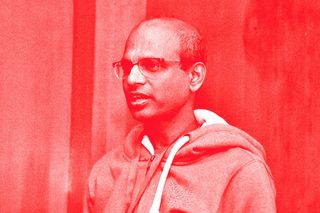
Director of IIT Mandi Blames Himachal Landslides on… Meat‑Eating
A concise guide on the rise of pseudoscience at the IITs

Laxmidhar Behera, IIT Mandi’s Director, reportedly asked students to stop eating meat because it’s causing landslides in Himachal Pradesh. “It is having landslides, cloudbursts and many other things again and again, these are all effects of cruelty on animals… people eat meat,” he said, adding that butchering animals has an effect on environmental degradation.
At face value, the meat industry does contribute significantly to greenhouse gases. However, so does agriculture, which leads to land degradation, desertification, and environmental pressures by way of large freshwater requirements. The questions of how our food production systems — both crop and meat — impact the environment are important ones if they were raised in good faith. That doesn’t seem to be the case with the IIT Mandi Director’s statements, who injected a moral argument against meat-eating in his hypothesis.
The incident raises questions about the scientific temper at higher educational institutes that are supposed to be the country’s best. Last year, Behera was in the news for claiming to exorcise “evil spirits” from a friend’s house by chanting mantras. Earlier this year, IIT Guwahati announced a National conference of Gau-Vigyan in modern life and medical science. Researchers at IIT-BHU actually conducted research on the benefits of cow urine and cow dung — not only for farmers’ utility, but also to pave way for “personal care products.” The team in question thanked the institute’s Director for supporting their study and furthering the Prime Minister’s Atmanirbhar Bharat initiative. In 2019, IIT Madras hosted a “pranic healer” who told students to “feel ether.” IIT Madras has already set up a “Sanskrit Chair” funded by Sant Rajinder Singh Ji Maharaj, “spiritual head” of the Science of Spirituality and Sawan Kirpal Ruhani Mission. In 2020, “the Indian Institute of Technology Indore introduced a class to impart mathematical and scientific knowledge from ancient texts in the Sanskrit language,” The Wire reported.
The seeds of pseudoscience were sown a while ago. In 2012, IIT Madras hosted a lecture by Vaishnavite preacher Tridandi Srimannarayana Ramanuja Chinna Jeeyar Swamiji, who said that humans didn’t evolve from monkeys, but are the children of god. In the same year, godman Sri Sri Ravishankar conducted a lecture in IIT Kanpur — with anecdotal reports on rationalist blogs of the demonstration of a “strengthening” Ayurvedic oil. In 2016, IIT Bombay ran a series of lectures, most of which were conducted by a seer — who reportedly owns a cow shelter — extolling the virtues of cow urine and dung, and of aeronautics in ancient India.
And that’s just in the IITs. The IISCs and NITs have also contended with the influence of pseudoscience, fielding talks by godmen and astrology workshops. The slow trickle of pseudoscience arguably gained momentum during a pivotal event in 2015: the Indian Science Congress. The event featured the presentation of papers on ancient aviation in India by Maharishi Bharadwaj, an event which followed the Prime Minister’s claims about the Hindu god Ganesha being the first example of a head transplant, and cited the mythological figure Karna as the first test-tube baby.
Related on The Swaddle:
A Research Competition Wants to Debunk ‘Cow Science.’ Do Facts Stand a Chance Against Beliefs?
There has, however, been pushback. Many campus faculty and students expressed condemnation against the platform given to the seer in 2016. In 2019, IIT Madras students protested BM Hegde’s lecture on campus — a cardiologist who was a proponent of “technobabble” like quantum healing. In the same year, researchers wrote an open letter to the Director of IIT Bombay, condemning his silence over Union Minister Ramesh Pokhriya’s pseudoscientific claims at the institute’s convocation ceremony. “He declared, ‘NASA is saying a computer that uses spoken language … can survive only because of Sanskrit.’ What is the basis of such a claim? Has there been a press release from the space agency? A personal communique to the minister himself? You know this as well as anybody that it was neither,” the letter stated. Pokhriyal also addressed IIT Kharagpur’s students, stating that our ancestors’ engineering prowess is proven by the fact that they built the Ram Setu bridge. There were also strong responses to a cancelled astrology workshop at IISC Bengaluru, where many also called for a larger, more sustained pushback from the scientific community at large to prevent the situation from worsening, Nature reported.
The pièce de résistance of politically motivated pseudoscience came in 2022, when IIT Kharagpur released a “Vedic calendar,” with the intent to correct the idea that Vedic culture isn’t indigenous. “The calendar is an embarrassment to an academic institution. On its first page, it declares itself to be a ‘rebuttal to the Aryan invasion myth’and promises ‘twelve evidences’ (sic). This evidence ranges from confusing claims about ‘law of space-time causation’ and ‘nonlinear flow and changes’ – whose relevance to the Indus valley is not clear at all – to the suspension of belief, in the form of a ‘unicorn’ – plainly a bull – depicted on a seal,” The Wire Science noted. This has harmful implications — it doesn’t just advance incoherent claims, but it does so with the agenda to further myths about “authentic” Indianness in order to declare some Indians as indigenous and others as foreigners. “The calendar also ignores well-established similarities among Indo-European languages, and fails to acknowledge that Dravidian languages are an entirely distinct linguistic family and that one example, Brahui, survives in Pakistan to this day,” The Wire added.
But the pattern shows how despite pushback from students and scientists, it’s the leadership across various institutes of science and technology which is failing, and is to be held accountable for the rise of pseudoscience across the board. In the absence of decision-makers committed to rejecting unproven claims and pseudoscience, the allowance of platforms for the “other side” at nationally renowned institutes gives pseudoscience validity as something to be investigated. The burden of proof, in other words, falls on detractors to disprove such claims once they’re made on legitimate platforms. It doesn’t just call into question the legitimacy of scientific institutions — it also prompts a rethink into the investment poured into said institutions, especially if resources now begin to be allocated toward “proving” made up facts.
Rohitha Naraharisetty is a Senior Associate Editor at The Swaddle. She writes about the intersection of gender, caste, social movements, and pop culture. She can be found on Instagram at @rohitha_97 or on Twitter at @romimacaronii.
Related


The Dark Legacy of Scientific Research Using Marginalized Bodies
